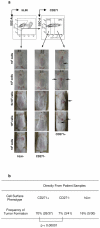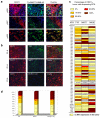Human melanoma-initiating cells express neural crest nerve growth factor receptor CD271
- PMID: 20596026
- PMCID: PMC2898751
- DOI: 10.1038/nature09161
Human melanoma-initiating cells express neural crest nerve growth factor receptor CD271
Erratum in
- Nature. 2011 Feb 17;470(7334):424
Abstract
The question of whether tumorigenic cancer stem cells exist in human melanomas has arisen in the last few years. Here we show that in melanomas, tumour stem cells (MTSCs, for melanoma tumour stem cells) can be isolated prospectively as a highly enriched CD271(+) MTSC population using a process that maximizes viable cell transplantation. The tumours sampled in this study were taken from a broad spectrum of sites and stages. High-viability cells isolated by fluorescence-activated cell sorting and re-suspended in a matrigel vehicle were implanted into T-, B- and natural-killer-deficient Rag2(-/-)gammac(-/-) mice. The CD271(+) subset of cells was the tumour-initiating population in 90% (nine out of ten) of melanomas tested. Transplantation of isolated CD271(+) melanoma cells into engrafted human skin or bone in Rag2(-/-)gammac(-/-) mice resulted in melanoma; however, melanoma did not develop after transplantation of isolated CD271(-) cells. We also show that in mice, tumours derived from transplanted human CD271(+) melanoma cells were capable of metastatsis in vivo. CD271(+) melanoma cells lacked expression of TYR, MART1 and MAGE in 86%, 69% and 68% of melanoma patients, respectively, which helps to explain why T-cell therapies directed at these antigens usually result in only temporary tumour shrinkage.
Figures



Comment in
-
Cancer stem cells: Invitation to a second round.Nature. 2010 Jul 1;466(7302):40-1. doi: 10.1038/466040a. Nature. 2010. PMID: 20596007 No abstract available.
References
-
- Weissman I. Stem cell research: paths to cancer therapies and regenerative medicine. Jama. 2005;294:1359–66. - PubMed
-
- Jamieson CH, et al. Granulocyte-macrophage progenitors as candidate leukemic stem cells in blast-crisis CML. N Engl J Med. 2004;351:657–67. - PubMed
-
- Singh SK, et al. Identification of a cancer stem cell in human brain tumors. Cancer Res. 2003;63:5821–8. - PubMed
Publication types
MeSH terms
Substances
Grants and funding
LinkOut - more resources
Full Text Sources
Other Literature Sources
Medical

